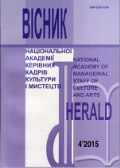Antique art as a subject of cultural studies by Grigoriy Pavlutskiy
DOI:
https://doi.org/10.32461/2226-3209.4.2015.138423Keywords:
Аnticonvulsive, аntique art, Corinthian architectural order, paintingsAbstract
The article deals with the most important works written by G. Pavlutskiy on the investigation of antique art done in different times. Basic points of development of the antique art which are under investigation have been mentioned. Attention is stressed on conclusions concerning the origin of Ancient Greek and Roman architectural forms, especially of those belonging to the architect order of Corinth and peculiarities of Ancient Greek painting. The scientific style is special.
It is pointed out that G. Pavlutskiy’s road to science started with studying the architecture of Ancient Greek and Roman. Its scientific value hasn’t lost its significance nowadays and it is unique from the point of view of the material having been acquired.
The author underlines the fact that no investigation of G. Pavlutskiy’s life and scientific work has been done. His pupils F. Ernst and M. Mykytenko were the first who wrote his biography. Since the beginning of 1990 several works devoted to his scientific activity have appeared among which the works by V. Afanasiev, E. Zharkov, O. Zavalnyk and others.
It should be mentioned that G. Pavlutskiy worked not only in the theoretical sphere. His works contend a lot of practical facts. Analyzing G. Pavlutskiy’s investigations, especially, those of ancient art, the author first of all pats attention to its practical value. Having chosen the architectural orders of Corinth as the subject of his investigation, G. Pavlutskiy given a detail description of its most important monuments. The author is pain attention to the conclusion, pointed by the investigator. This conclusion tells that the most important quality of these monuments is simpliaty of their forms and strict decorations.
The author thinks, that the last chapter of the work "The order of Corinth in Rome" is the most interesting.
G. Pavlutskiy many times pointed out that the architect order of Corinth in Rome collapsed. The author finds originality of G. Pavlutskiy’s ideas, which lies in the fact that G. Pavlutskiy tried to prove the collapse of Roman architecture. Excessive ornamentation badly influenced nobility and beauty of the architecture of Corinth. That’s why they stand apart from purity of the style.
G. Pavlutskiy’s dissertation, which deals with genre subject in Greek art of pre-Hellenistic period is accentuated. The investigated material gave the author opportunity to find out that the aim of this work was firstly showing the interest of Greek artists in surrounding reality and then defining directions and nature of the Greek genre.
The work consists of five parts and is built on problematic-chronological principles. G. Pavlutskiy shows
evolution of genre art in ancient Greece from the times of the Miken civilization to the epoch of Hellenism. The preellenistic art is analyzed in the dissertation a little bit other way than it was done by his predecessors.
G. Pavlutskiy marks that studying art of XIX century led him to investigation in this field. Modern trends of symbolism or decadence are not new in art. They find their prototype in ancient Greece.
Great interest in development of art in ancient Greece forced G. Pavlutskiy to examine one more aspect –
peculiarities of painted ceramics. He shows evolution from primitive ornament of Micen vases to anatomically measured proportions of human bodies in the works of ancient potters.
G. Pavlutskiy gives a detailed description of architectural and painting memoranda of ancient art. G. Pavlutskiy had his own scientific style, which on one hand has gained practical material and on the other hand gives profound theoretical analyses.
The manner of representing of scientific material, distinguish. G. Pavlutskiy’s works among others scientists of the second half of the XIX and the beginning of the XX centuries, and make them interesting for the scientists of the XXI century.
Downloads
Published
Issue
Section
License
Authors who publish with this journal agree to the following terms:
1. Authors retain copyright and grant the journal right of first publication with the work simultaneously licensed under a Creative Commons Attribution License that allows others to share the work with an acknowledgement of the work's authorship and initial publication in this journal.
2. Authors are able to enter into separate, additional contractual arrangements for the non-exclusive distribution of the journal's published version of the work (e.g., post it to an institutional repository or publish it in a book), with an acknowledgement of its initial publication in this journal.
3. Authors are permitted and encouraged to post their work online (e.g., in institutional repositories or on their website) prior to and during the submission process, as it can lead to productive exchanges, as well as earlier and greater citation of published work (See The Effect of Open Access).


